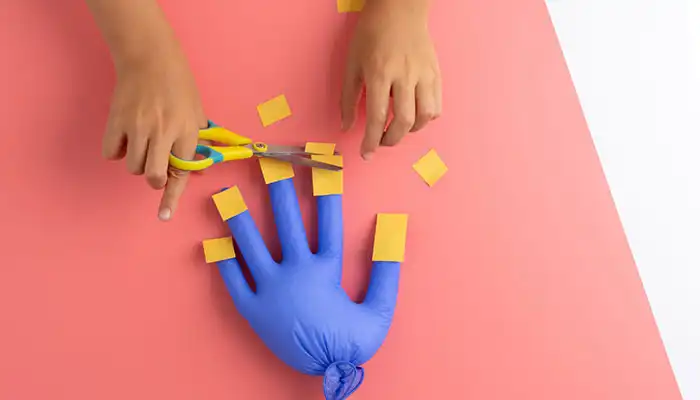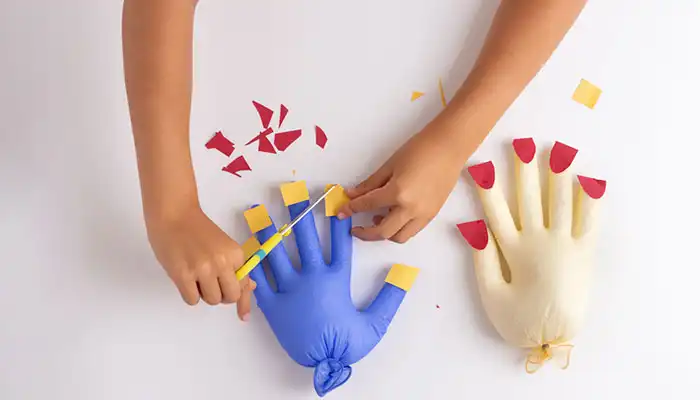Easy Printable Scissor Skills Practice for 4-Year-Olds
Why Scissor Skills Matter for 4-Year-Olds
If I were to ask you what is the most important skill for early childhood development, what would be your answer? First sight probably came ‘holding the pencil properly and recognising shapes’ but WH is MUCH easier than it looks like. First of all, your child might not be ready for the pencil yet, but he most likely needs to learn holding scissors a.s.a.p. These are a big challenge and will work all the tiny muscles in a bunch, but as soon as your kiddo cuts through the paper on his own he will feel awesome – and that’s what easy scissors skills printables for preschoolers are for.
The Real Benefits of Scissor Skills Practice
OK, let me cut to the chase: scissor skills are not about cutting paper. But they are about developing fine motor skills that will help children move to more advanced tasks, such as writing, buttoning a shirt or brushing their teeth, when they are 4, 6, or 8 years old. Every time 4-year-olds practise cutting, they are developing the hand strength and coordination to master multiple tasks later on. This is not just about snipping: it is giving it time.
Why Is Cutting So Challenging for 4-Year-Olds?
All right, I am at least going to look you in the eye about this. Cutting with scissors is not as straightforward as the commercials want you to believe. For little hands, gravity and physics are not cooperative. Sure, how hard could that be? In fact, it is really tough for 4-year-olds who do not have the strength of coordination to keep the scissors open and shut and flick them in the right direction. Something like rubbing your belly and patting your head, really. That is the real reason that scissoring with jackets in class is so important for developing hands. Practice makes perfect.

Choosing the Right Scissors for Your 4-Year-Old
Now then, before we get to the worksheets, let’s talk tools. Not all scissors are created equal, particularly when your kids are small. You’ll want to find a pair that can adequately fit their little hands — think blades with a safety edge that are less likely to cut their skin, and handles that are the right size. It’s a common recommendation to use scissors by Fiskars, which offers a variety of kid-friendly designs with rubber-coated handles that have been shaped to make it easier for children to maintain control of the scissors. These aren’t just scissors — they’re training devices to aid your child’s development.
Designing Easy Printable Scissor Skills Practice Sheets
Okay, here’s the fun part – how to make those scissor skills practice sheets I mentioned that are so easy for you to cut out! Your best sheets start easy and increase in difficulty. Your child can follow a straight line. Then a curve. Then a combination of the two. They can cut out a circle. Then a square, and so on. Notice that each cut has a purpose: to follow a line, a corner, a curve, a corner, or into a shape. Let them practise one each day, gradually increasing the difficulty as they become more confident.
For instance, a page of worksheets might start out with straight lines, crossing the page left and right – after a few days with an adult partner, progress to zigzags or wavy lines – and, if your kid is up for the challenge already, you’ll go on to cutting out easy shapes such as circles and squares. Pair the lesson with a little praise for each newly-acquired short skill, and the whole process will seem less frightening and more enjoyable for your small human.
Integrating Scissor Skills into Daily Activities
These worksheets are not the only (or even best) way to practise scissor skills. Some of the most natural scissor practise during the day comes from real-life activities. Imagine that you’re cooking dinner. Give your child a piece of paper to cut up while you’re chopping. If you’re doing an art project, ask your child to cut out pieces to go into a collage practise part of the normal flow of the day, not as a separate, obligatory task. Your child doesn’t feel like they’re practising a skill, they’re enjoying themselves.
Making Scissor Skills Practice Engaging
Sorry to be blunt but, really, how long can you expect a 4-year-old to withstand anything by sheer virtue of its being something they have to endure in order to keep up with the group?
At this age, everything needs to be as game-like as it’s possible to make it. Plus, the fact that your child is with you and that this is something you’ll do together, as opposed to something he has to do under difficult conditions anywhere else, adds a motivational layer to its own.
Now, make it a ‘cutting challenge’ (can you make the line straightest? The waviest?) and – voilà! – you’ve got a game with a challenge baked in. A bit of competition (however only with themselves) worked like gangbusters to keep Owen’s spirits up while we were working on his scissor skills.
Step-by-Step Guide to Using Printable Scissor Skills Sheets
Okay, so you’ve got the worksheets—what now? Here’s how to get started:
- Prep the Space: Bring your child’s workspace into the kitchen where he or she can do the cutting and gluing. Make sure your child has what he needs – the scissors and the printable worksheets within a good eye-line.
- What: Explain the Task: what you will be having them do before cutting begins. Demonstrate what it looks like to hold the scissors and do it correctly if necessary.
- Break it Down: Start with the easiest task on the worksheet, for instance, cutting a line. See if they can do it by themselves first. Then, you can offer help where needed.
- Praise: Praise Everything. Praise the cutting through the paper without a tear, praise the following the line almost straight. Encourage.
- Ramp it up a bit: As they build proficiency, progress through to the more challenging worksheet modules. Add the curves and allow the adventures to get more intricate, but stay within their comfort zone.
Safety First: Tips for Supervision
Safety concerns are often raised in discussions when scissor skills are called up, so one last point: When your child is beginning to use scissors, be sure to have an adult present to monitor the activity – even with the safety of child-sized scissors and the elimination of sharp points, accidents can happen.
Teach your child to avoid walking or running while holding scissors in hand, teach him or her to always walk away from the art project or paper with scissors in a hand, and always walk with the points of the scissors down – not up where they could accidentally catch on something, take the air, and fly into someone’s eye – as that would be, well, undesirable.
Making safety part of the salient lesson that occurs when little scissors are involved is almost more important than the art that results.
Additional Resources for Scissor Skills Development
And there are plenty more ideas to encourage scissor skills – websites such as Twinkl and Education.com have numerous printable free scissor skills worksheet templates. Educational books and toys are always a good source to develop fine motor skills in youngsters as well – just try to keep the activity varied and fun.
Conclusion
When they spend time learning easy printable scissor skills practice for 4-year-olds, they’re actually training and getting ready for a whole suite of more complex actions. By equipping them with the most suitable tools, accompanied by a selection of relevant worksheets and heaps of praise, you’re giving them the chance to formulate a ‘tool kit’ that will set them up for success in a whole range of educational pursuits. They might not even realise this – but you are! Grab the scissors, hit print, and slowly cut away!
Easy Printable Scissor Skills Practice for 4-Year-Olds
Incorporating Fun Themes into Scissor Skills Practice
There are numerous ways to keep a 4-year-old interested in a given activity, and creativity is your biggest asset: scissor worksheet for practice will be that much more fun if the worksheet is paired with a theme! Consider, for example, a jungle theme with a worksheet requiring your 4-year-old to cut out various leaf shapes or curly vines, all of which grows different animals! Or, a similar space-themed sheet featuring stars and rockets!
The Role of Repetition in Building Scissor Skills
Repetition is another vital piece of the puzzle. It may seem tedious, but being able to do anything well requires repetition. Your child exercises their muscles each time they cut along a line or shape, essentially building muscle memory and achieving a smoother, more confident movement with practice. Learning to ride a bike, for example, is much the same: with each iteration, your child gains just a bit more at the end of each attempt. So, repeat your easy printable scissor skills sheets again and again! Consistent use is integral and invaluable.
Using Scissor Skills Practice to Boost Confidence
After all, every time a 4-year-old makes a successful cut, he or she gains another bit of confidence – something vital at this age. The better your child is at cutting, the more likely they are to tackle trickier tasks with gusto. It’s called the ‘halo effect’ (not to be confused with the ‘halo effect’: the tendency to think highly of people because they’re attractive and there is the ‘halo-hurting effect’ where our primal brains trick us into thinking someone is less attractive if they’ve done wrong). So, keep on encouraging, and watch those new skills spill over into other learning.

FAQs About Scissor Skills Practice for 4-Year-Olds
What should I do if my child struggles with scissor skills?
It’s totally normal for the child to struggle at first. Start with shaped-stain exercises (paragraphs) like cutting a straight line, and offer encouragement. If they are still struggling, use thicker paper or practice materials that are easier to hold.
How often should we practice scissor skills?
Ideally, your child will practise for five minutes a day, but whatever you do, keep it up. Sessions don’t have to be overwhelming. Weave scissor practice into playtime or craft activities, to make it fun.
Can scissor skills be integrated with other learning activities?
Indeed, scissor skills can be practised alongside other activities such as colouring, counting or storytelling. When the scissor practice is done, your child can colour the shapes, count how many shapes he or she produced, or use the pieces in a creative story.
What are some signs that my child is ready for more advanced scissor skills?
If your child is cutting comfortably along straight lines and simple curves, he may be ready to use the same skills to create more elaborate designs and projects. Take this ability one step further by using more intricate patterns – or by cutting the object into smaller shapes.
What should I look for in a good pair of scissors for my 4-year-old?
When shopping for safety scissors appropriate for children, look for those that are designed especially for young children, with an easy grip and rounded tips. Find scissors with safety blades to cut paper but also allow your child to use them safely. Another great feature is adjustable tension; that way the scissors will still fit as your child’s hand gets stronger with use.
Integrating Scissor Skills Practice into Everyday Learning
Although we use paper cutting for teaching and practising scissor skills given its convenience, don’t be limited. Find possible ways to include cutting tasks in everyday learning. For instance, when teaching shapes, have your child cut out shapes from coloured paper; when learning letters, they can cut shapes to practise the letters made. This keeps the learning still relevant to their other educational activities.
Creating a Scissor Skills Progress Chart
kids like to see how far they’ve come and a chart can be a great motivator Draw up a chart that shows them their accomplishments in cutting, maybe one box for cutting a straight line, then another box for cutting a curve, then finally cutting out a circle. As they achieve a new skill, let them stick on a star (or a sticker) on the chart. They can even draw the stars themselves. Kids like to see how far they’ve come and a chart can be a great motivator. This little bit of recognition can make your preschooler want to practice even more.
Making Scissor Skills Practice Social
Why not make scissors skills practice more eventful by doing it as a group? Bring in your co-conspirator(s) – can be siblings or other friends – by turning it into a small group activity. For example, you can establish a ‘cutting party’ with each child having a worksheet to do simultaneously. Apart from making the practice fun, you could use the small group to reinforce other aspects of your child’s learning, such as learning to share and work as a team. Not only that, children tend to learn more quickly when they’re spurred on by their peers.
Exploring Different Materials for Scissor Practice
Paper is just one option for hand-eye co-ordination practice. Instead or in addition to using paper, try fabric, foam sheets or even Play-Doh. Each has a slightly different feel and handful, and is cut in different ways, not just for challenge but way learning. To improve fine motor skill strength, cut fabric. Cutting a single strand of spaghetti is better for precision learning. Foam sheets also work well. Cutting them in one direction improves transfer skills, and cutting them into shapes promotes eye-hand co-ordination. Mixing it up makes for more exciting learning.
Storytime Meets Scissor Skills: A Creative Twist
Kids can practise cutting by turning storytime into a tutorial of sorts: For example, you could create a simple cut-and-paste story where each page has a skill to practise. One page might have a character who needs help cutting out shapes to build something. As the child reads along, your child can help by completing each cutting task. Riegel, when comparing such ‘pretend play’ with executive function, finds that this type of embodied step-by-step activity leads to better learning.
FAQs About Advanced Scissor Skills
When should I introduce more complex cutting tasks?
Once your child is comfortable with simple shapes and lines, you can gradually offer more complex tasks, with worksheets that include more detailed shapes or patterns, but always tailoring to their readiness.
What other tools can help improve scissor skills?
Tools such as a hole puncher, tweezers, or even very small tongs can help to develop the same dexterity that cutting requires, and can be introduced quite easily into play. This gives children more occasions for practice.
How can I make scissor skills practice less frustrating for my child?
Divide the task into smaller steps and provide lots of praise. If your child is floundering, find an easier way to do it or take a break. But keep practise fun and pressure-free.
Are there any digital resources for scissor skills practice?
Yes, there are many great educational sites, and they often have worksheets that you can print out; some even have interactive cutting games that you can do on a tablet. You don’t need me for those. But nothing takes the place of hands-on practice.
How can I ensure my child is using scissors safely?
Make sure you’re always supervising scissor practice, and teach your child some basic scissor safety rules, such as never running with scissors, always holding the scissors by the handle, and that they’re tools, not toys.
Wrapping Up the Journey with Scissor Skills
In addition to enhancing your preschooler’s cutting skills, easy printable scissor skills practice for 4-year-olds helps children grow in self-assurance, improve their fine-motor dexterity and, yes, have fun. By doing these activities with your child every day, you’re actually going far beyond cutting – you’re giving your child the confidence and competence to tackle all sorts of endeavours as they grow into young adults. So keep those scissors handy, and keep on cutting!



